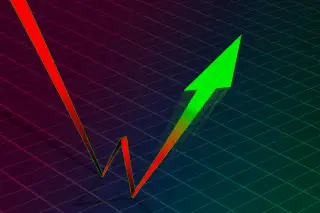Why the Recent Stock Market Plunge May Bring 'Buying Opportunities for Patient Investors'

Stocks endured their worst day since June 2020 this week. But here's the good news: Big-one day drops in the market are often followed by above average returns.
The S&P 500 ended Tuesday down 4.3% while the the Dow Jones Industrial Average fell 3.9% and the Nasdaq Composite dropped 5.2%. The plunge came after a higher-than-expected inflation report, which had investors worried that the Federal Reserve may not be able to slow or decrease the size of its interest rate hikes soon.
All three indexes closed slightly higher on Wednesday, but experts say the short-term outlook for the stock market will rely heavily on inflation numbers — and how the Fed reacts. The central bank tends to hike interest rates in order to help battle spiraling prices, and yet doing so can also crimp the prices of financial assets like stocks.
While the price drops may seem painful, they also present an opportunity for investors over the long term.
"Based on history such steep daily declines have proven to be buying opportunities for patient investors willing to wait out volatility,” LPL Financial portfolio strategist George Smith wrote in a blog post highlighting the data.
How stocks react after big one-day drops
Since 1928, the S&P 500 has delivered returns of 5.9% on average three months after daily drops larger than 4%, according to LPL's analysis. Six months after those one-day drops, the index's average return was 7.6%, and one year after, the average return was 15%. The median returns were 3.1% at the three-month mark, 7.9% at six months and 11.2% at one year.
Daily declines over 4% happen almost twice a year on average, but cluster around recessionary periods, Smith wrote in the blog post. There were 156 drops of that size in the data LPL looked at since 1928.
Keep in mind: "The lower proportion of positive returns after such drops does lead to extra caution when interpreting this data," Smith wrote. The index was positive just 55.5% of the time three months after a big daily drop, 63% six months after and 58.4% one year after.
But, he notes, using only data from the modern formation of the S&P 500 in 1957 — which obviously skips the Great Depression — the average returns are even stronger six months out.
The takeaway is that investors can have a reasonable expectation that stock prices will nudge higher in the near future, though nothing is ever guaranteed and it's generally best to avoid knee-jerk decisions to buy or sell. Financial advisors tend to recommend not reacting to daily market moves — especially because yanking your money out of the market could mean missing some of the market's best days.
Instead, focus on a long-term investing strategy that aligns with your goals, timeline and risk tolerance.
More from Money:
Stocks Just Had Their Worst Day Since 2020. What's Next?
7 Best Online Stock Trading Platforms of 2022
Is 'Buy the Dip' Dead? Investors Are Avoiding the Popular Strategy This Year